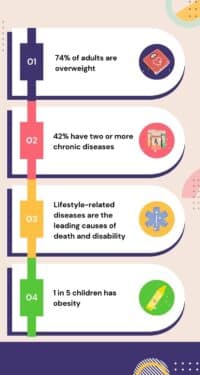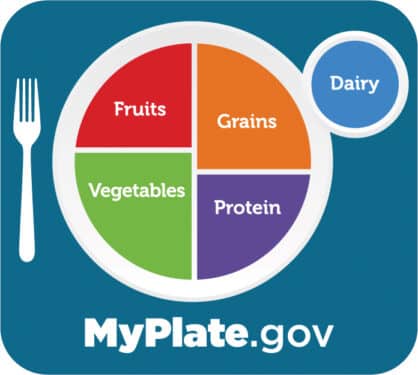How did America's nutritional guidelines become and how will it affect the health of Americans
The truth was examined by Ros Lederman
The Americans have their work for them when it comes to health. Statistics paint a distinctive image, from weight to chronic diseases.

Diet has played a major role in these patterns, and since the 1980s, Americans have looked at the nutritional guidelines of Americans (DGA). DGA was a public health education institution and a country's policy, as it provides science -based recommendations for a healthy diet. A variety of people who educate the public refer to: government agencies, doctors, nutritionists, nurses and other health professionals.
“DGAS depends on the overall latest research that compares the data published on diet, eating habits, food, and eating nutrients – all of which continue to develop over time,” says Linda Van Horn, PhD, Registered Dietician, Professor of Preventive Medicine, and Head of Research Department at Northwestern University at Finnberg University.
However, poor health in the United States has skeptical of food guidelines. Critics claim that they led to high rates of obesity and chronic diseases, politically affected, and lacks transparency.
A closer look at food instructions tells a more complete story. Less than 10 % compare people in the aftermath of DGA, which makes the abstract instructions in the rates of chronic diseases. In fact, following the instructions may be part of the solution.
“Americans tend to excessive salt, sugar, and unwanted fats-especially in high-treated foods-fruits, vegetables and other products of the type of product,” says Van Horn.
However, research shows research that after nutritional guidelines may lead to a low risk of high blood pressure, cardiovascular disease and type 2 diabetes, it may support bone health in general, says Kevin Petro, PhD, registered nutritionist, assistant professor, and director of nutrition programs at Luila University.
The process is behind the instructions
Every five years, the law requires the update of DGAS. The process begins with an independent expert committee that performs a comprehensive review of the latest research. The committee members are examined for conflicts of interests and must meet some pre -standards that guarantee the balanced member council.
“The Consultative Committee for Food Guidelines consists of recognized experts at the national level in the field of nutrition and health,” says Van Horn.
Representatives of the US Department of Agriculture (USDA) and health and human services (HHS) provides support to independent scientists because they create what is known as DGAC. The committee holds meetings available to the public during the formulation of the scientific report, and historically, there were many opportunities for public comments, although HHS during the reign of Robert Kennedy Junior has cut many public comments, claiming that it slowed this process.
For the latest DGA report, the audience made nearly 10,000 comments during the December 2024 comment period to February 2025. Viewed in the regulations. Gov (Dockket HHS-Yash-2022-0021). 79 additional speakers made comments at a virtual meeting on January 16 open to the public.
The final DGAC scientific report is available to the public and is presented to officials in the US Department of Agriculture and HHS, who use the report and recommendations from the committee to formulate the final guidelines.
This comprehensive review process means that with the growth of scientific and medical societies in health and nutrition, the guidelines are adapted. However, the common complaint between DGAS critics is that the instructions change over time, which indicates in the view of critics that the information is not reliable. This perspective, though, ignores the benefits of the world of advanced health sciences constantly.
“The original DGAS had a great focus on lowering high fats and saturated fats and sodium consumption,” says Van Horn. “Over time, with more and more research, DGAS has advanced to emphasize the very important role of fruits, vegetables, whole grains and dietary fiber.”
This is an example of changing confirmation, although the total information remained consistent.
“Some aspects have stood up to test time,” says Petro. “This includes eating a wide range of foods, eating more fiber -rich foods, and avoiding excessive amounts of saturated fat.”
Portrait

DGAS has also evolved, as well as visual, which leads to its current repetition: MyPlate. Retired food pyramid has now served as an early effort to intensify DGAS to coordinate easy digestion. These visual means make the instructions easier for everyone.
“Myplate offers individuals a way to organize every meal to align their consumption with DGAS,” says Petro. “Four food groups arranged on a dish (vegetables, grains, fruits and protein) and encourages the inclusion of dairy to the side.”
MyPlate recommends that fruits and vegetables form half of your plate, focusing on vegetables; A quarter of the grains should be focused on whole grains; The remaining quarter should be a lean protein. Dairy products, such as low -cut milk, yogurt, cheese, or fortified soy milk, on the side.
This simple formula captures a lot of what DGAS currently recommends. Although there can be many layers and improvements to a healthy diet, the shift towards meals that follow the Myplate format can significantly affect health.
After all, at its heart, it is caused by strong scientific research in the nutritional, cultural and environmental factors that affect nutrition and health. They are just good like the flag behind them. The financing quality research ensures that accurate information directs recommendations.
By providing science based on food recommendations, DGAS fills an essential role in public health. How people use DGAS to determine their real effect.

